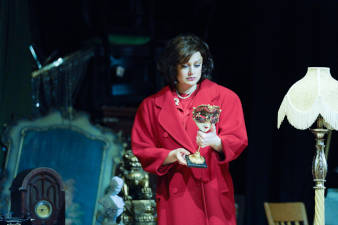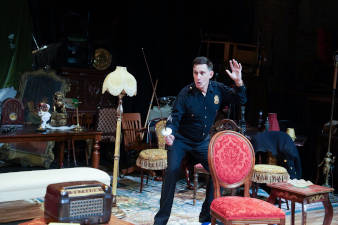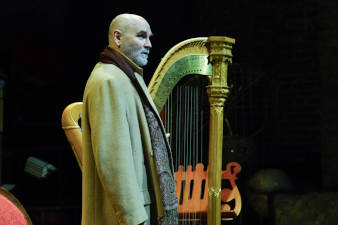
|
Beate Hein Bennett
At What Price…it’s
all in the viewpoint!
It has become a rare occasion to see a modern classic, especially one that resonates loudly in our mercurial times where the newest news and information are stumbling over each other and leave us stunned by the chaos. “The Price” by Arthur Miller (1915-2005) is such a modern classic. It originally premiered in New York in February 1968, another chaotic period. The present superb production proves the perennial validity of Arthur Miller’s dramatic exploration into the American psyche as it plays out within the nuclear family. His genius of uncovering the core of the social sickness at the heart of this country was in peeling away the layers of social pretentions: seeking status and power through economic and professional success, pursuing happiness through material possessions, espousing a hyper-individualistic freedom. All this is known as chasing after The American Dream, a chimera that hounds all who come to this country. Arthur Miller’s father, a Jewish immigrant from the Russian Pale of Settlement and successful businessman until he lost it all in the stock-market crash of 1928 was such a man. In play after play, beginning with “Death of a Salesman” (1949), Arthur Miller takes the scalpel to the American body politic and exorcises bit by bit the actual rot to the soul of the individuals caught in this race, the much celebrated potent dynamic of socioeconomic mobility in the United States where anything and everything is deemed possible.
“The Price” is set in the attic-like 2-room apartment of an old condemned brownstone on Manhattan’s Westside. All the furniture of the once grand household is sitting there helter-skelter waiting to be disposed of. This collection of furniture becomes the paradigmatic locale for the ensuing family drama. The entire brownstone building was the original home of the once prosperous Franz family, and the entire furniture inventory must be removed before the arrival of the wrecking ball. A used furniture dealer has been contacted by Victor Franz, one of two sons, to make an appraisal of the value and purchase the entire collection. (The father who had lived out his life in this attic has been dead for sixteen years.) The crux of the play lies in this very issue: Does anything or anybody possess a lasting value and how is this value judged and by whom? Enter Gregory Solomon, the dealer, a nearly ninety year old wisecracking wise old man who has seen it all. Throw into the mix Victor’s ambitious wife, Esther who hungers for a more generous life than is possible as a policeman’s wife. Finally, Victor’s estranged brother Walter appears; he is a successful surgeon who comes for an unannounced visit and purports to have no interest in any of the furniture. The drama unfolds as these four characters fence with each other over material value, pretensions, truth and lies, justice and moral values. Miller’s text is dense and rich, reverberating with the personal pain and resentments within the Franz family, and revealing the systemic social ills of economic injustice. The Village Theater Group is presenting “The Price” as its inaugural production. The producers, Daniel J. Condon and Andrew Beregovoy have engaged a talented and experienced group of artists who give new and relevant life to this play. Director Noelle McGrath together with lighting designer Isaac Winston create a magnificent ambiance in which the presence of the four characters is intimately interwoven with the furniture as significant pieces gain importance as the vestigial remnants of the luminous past of the Franz family but also as witnesses to Victor’s and Walter’s past experiences with their parents. A green armchair, the “throne” of their late father, and the impressive harp, the symbol of their mother’s foiled musical ambitions, become the central objects in the conflict. The set of the impressive furniture collection was assembled and arranged by the Village Theater Group as a collaborative effort.
Bill Barry as Victor Franz in full police sergeant uniform makes his quiet entrance. As he takes off his cap, his jacket, and his gun belt, he wanders around the furniture, gently touching some pieces, chuckling to himself, until he finds his fencing mask and rapier, drops briefly into position and realizes his knees are no longer what they were. His subtle performance as “Vic” is a study of an upright, straight-talking but complex man. Janelle Farias Sando makes a splashing entrance as Esther, a pretty woman, in a bright red ensemble with matching coat, suit, purse and shoes. (Costumes designed by Bridget McJohn)The difficulty for a contemporary audience of appreciating her role lies in the development of women’s roles since 1968, and perhaps Miller’s ambivalent attitude towards the role of women; she seems to come off first as a spoiled woman with outsized material ambitions but no outlet. However in Ms. Farias Sando’s portrayal she ultimately gains in stature as she tries to mediate between the brothers and recognizes the true value of her husband’s ethics.
Gregory Solomon is played by Mike Durkin beautifully with enormous energy and whimsical charm and the cunning of a life-long dealmaker—very different from the more subdued original actor Harold Gary’s performance in 1968 that I remember. His central personality is in striking distinction from the Franz brothers. It is an important component in the quartet of characters—each is a distinct instrument in the text. Last not least enters Walter Franz, the older brother. He is played by Cullen Wheeler as a self-assured man, quite self-possessed in his status as surgeon with a successful career. However, as the veneer of self-importance is scraped off bit by bit in the uncovering of his unhappy private failures in life, Mr. Wheeler shows the pathos of a man in moral self-defense. Arthur Miller had stated in his Afterword to the published script that a balanced treatment of both brothers is essential for the empathetic understanding of the conflict between them. This balance was certainly achieved in this production.
Theatre at St. Clements is the perfect space for this intimate portrayal of the American Dream that turns so easily into a nightmare. The large stage space allows for the enormous collection of used furniture and stuff, the play’s central symbol. As Solomon would have it: “What’s the key word today? Disposable. The more you can throw it away, the more beautiful. The car, the furniture, the wife, the children—everything has to be disposable. Because the main thing today is—shopping. Years ago a person, he was unhappy, didn’t know what to do with himself—he’d go to church, start a revolution—something. Today, you’re unhappy? Can’t figure it out? What is the solution? Go shopping!” If you want to see the human cost, go see “The Price.” It is a sobering experience. In an old brownstone on the Westside of Manhattan! |
| recordings | coupons | publications | classified |




